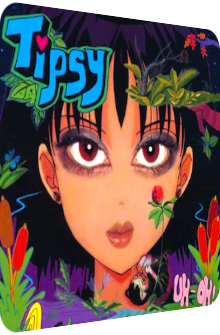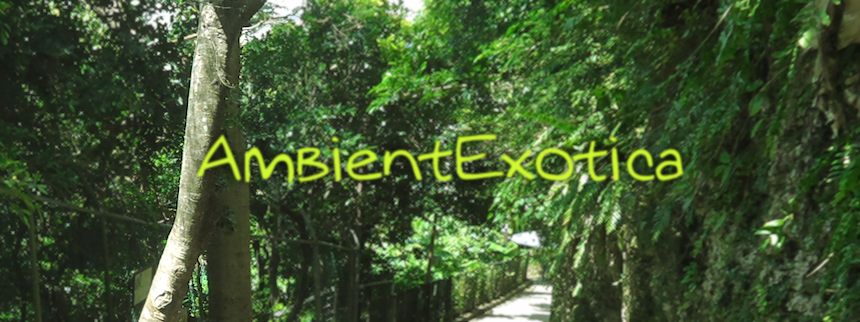
Tipsy
Uh-Oh!
2001
Imagine music of tropical dimensions with dozens of references to vintage records, bits of Americana, a pinch of psychedelic tiki flavor plus a potpourri of different Caribbean and Latin music genres, and you will most probably wind up in the territory of Tipsy, the electronic mash-up and montage project of Tim Digulla and David Gardner from San Francisco. Distantly similar in scope to The Avalanches' Since I Left You LP, the jazzy quirkiness of Mr. Scruff or Jan Jelinek‘s faux-Society For The Emancipation Of Sampling, Tipsy‘s second album Uh-Oh! doesn‘t contain Exotica tracks as a byproduct, but concentrates on the genre‘s premise of lush, relaxing pieces and erupting, menacing chants for savage-inhabited jungle villages. Since this music cannot be produced overnight, the gaps between the band‘s albums span about 6 years on average.
While the band‘s first album Trip Tease from 1996 ventured into Mexican lands in a bunch of its tracks, Uh-Oh! is the most tropical album overall, while the third album Buzzz, released in 2008, offers a more dance-oriented take. Despite Tipsy‘s sample approach, the duo gathered 16 instrumentalists and vocalists in the studio, though not everybody at once, and present a welcome range of instruments like sitars, theremins and vibraphones. Since these instruments are oftentimes emulated by synth hardware on electronic records, their inclusion is a huge plus in my book. Uh-Oh! contains a huge amount of 18 ambiguous-salaciously titled tracks, all of them below the 4-minute mark, and shuttles between various styles and moods. This isn‘t just a scintillating sunshine album, but an equally spooky one at times; everything you hear, however, was created in good fun and is light-footed and easy to digest; read about a few examples off the album in the next paragraphs.
Hard Petting is built on a boogie-woogie groove with both playful bits, for instance exotic flutes, high vibraphones and funk guitars, and ethereal elements of which the gorgeously tense string sections come to mind. Papaya Freeway is a mercurial ditty that features cascading pianos, reverberating vibraphone notes, echoey congas, surf guitars and permanent shifts in rhythm and percussion. Mexican brass sections are interchanged with Oriental sitar melodies and shawm sounds. On the electronic front there are fake-didgeridoos and tremoling electric pulses. The following Hey! is a pressing spy theme with short brass bursts that are interwoven with quieter Hawaiian surf guitar grooves. Cartoon noises are thrown in, and the signature »hey!« sample is heard often. This is one of my favorite tracks of the album and surprisingly coherent.
In Neon Tetra, several elements are juxtaposed: it contains fragments of roulette table samples, delicately mysterious strings, vibraphone sprinkles, glockenspiel bits, mystery chimes, radio frequency signals and short clarinet cries in Tony Scott‘s style. While upbeat in style, most of its ingredients are quite tense. Wig Out is a Hawaiian-style clog dance farrago with hectical bubbling frequencies, spaced-out theremins and mischievous accordions in Casio style, while the follow-up Reverse Cowgirl is a hyperactive jumbling horse ranch chanty with ukuleles, bass guitars and short brass intermissions. Swallowtail is based on an exhilarant dub groove and several ingredients like samples of romantic string sections, trombones, Hammond organs, pristine vibraphones and laser-like sound effects rush past.
Kitty Takes A Ride is another piece that oscillates between spacey impish bits and lush sections. It features a barrel organ melody as its base frame and introduces short bits of claves, bird noises, primeval forest sounds and harp chords to the mix. There is no way to adapt oneself or concentrate on a particular sound, because everything comes in and moves out quickly. Fur Teacup transports a proper Exotica feel with distinct marimba backings, eerily strolling strings, a distant theremin with an added wah-wah effect, a flute played in a clichéd indigenous style. The track ends with a burst of an arcane, uncanny string ensemble.
Pink Mood shifts the style and is a stormer of a track, which is tremendously dream-like and overly lush. Loops of salving strings wash over the listener, heavily echoed drone sounds are backing the strings and striking xylophone riffs make this a totally unexpected song. The former playfulness is completely gone and the listener is encapsulated in mesmerizing waves of bliss. A favorite of mine, unsurprisingly. The same can be said about the following Bunny Kick which re-introduces the jocular modus operandi with ukulele pluckings, beautifully kittenish »Oh Yeah« vocals, soothing »aaah-aaah« chants, tropical background strings and an overall carefree attitude. This is another song which, considering Tipsy‘s mash-up style, can be almost called stripped down, as there are no elements that distract from the tropical atmposphere. In fact, everything fits together flawlessly.
Suez Motel changes the mood once again and is the darkest song on the album with a distinctive Oriental mood with lurking dangers. Sitars, Chinese Gongs, wind chimes and sustained background strings evoke a feeling of riskiness and unertainty. Even though this comprises of another clichéd Western viewpoint on Oriental and Middle Eastern sounds, it does work tremendously well and changes the tone of the album completely, as did Pink Mood before. Seaweed is yet another favorite of mine, with lush piano jinglings, middle wave frequencies, distant Hammond organs and pristine xylophones. The mood is cozy, and only occasionally dominant drums break the illusion of a soothing alternative reality.
Zombie‘s Mood is the last dark track of Uh-Oh!, although it starts sumptuous with attractive vibraphone washes. However, the reverberated bamboo drums, the occasional saxophone note and eerily mysterious string sections make this a curiously cozy yet tense offering which is absolutely fine by me. And finally, eerie vocals and melancholic strings culminate in the last track Eclipse Of The Sun Virgin. Steel guitars, hectical beats and synth bubbles let the album end on a shilly-shally mood, quite an unexpected turn considering the vast amount of tropical playfulness in the majority of Tipsy‘s 18 tracks.
To my mind, Uh-Oh! is the perfect introduction for listeners of electronic music to the realm of the Exotica genre. This is no mediocre lounge music record, but an expertly stitched mash-up example. The band blends the different styles confidently and creates a concentrate of several decades and fashions that is unique. Once a listener is at least slightly interested in Tipsy‘s offering, the next step to the real Exotica music of the late 50‘s isn‘t that far away and probably the logical conclusion. On Uh-Oh! there is always something going on, with hundreds of effects and snippets entering and leaving the mix. The large variety of styles gathered on the album means that there is something for everyone, which implies that virtually no one can adore all of the 18 tracks. But since there is no weak link and the sound quality is as flawless as the realization of the ideas, I recommend this album to those listeners who want to inhale a deep breath of different styles, vocal bits and sound fragments in one go. Tipsy deliver for sure with their most exotic album.
Ambient Review 045: Tipsy – Uh-Oh! (2001). Originally published on Mar. 10, 2012 at AmbientExotica.com.
